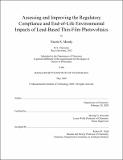Assessing and improving the regulatory compliance and end-of-life environmental impacts of lead-based thin-film photovoltaics
Author(s)
Moody, Nicole S.
Download1192965263-MIT.pdf (9.130Mb)
Other Contributors
Massachusetts Institute of Technology. Department of Chemistry.
Advisor
Moungi G. Bawendi.
Terms of use
Metadata
Show full item recordAbstract
Emerging thin film photovoltaics (PVs) with photoactive layers based on quantum dots (QDs) and perovskites are a promising source of low-carbon renewable energy. Their solution-processability and compatibility with flexible substrates could allow for low-cost, high-throughput production with decreased factory start-up costs as well as deployment in new and underserved markets. However, the highest-performing QD and perovskite materials for PV applications are lead-based, which could prevent their commercial deployment due to regulatory restrictions, or lead to negative end-of-life environmental impacts from lead contamination. In this thesis, I evaluate the regulatory requirements of emerging lead-based thin-film PVs based on lead halide perovskites and lead sulfide (PbS) QDs. Using European Union Restriction of Hazardous Substances (RoHS) Directive and United States Resource Conservation and Recovery Act (RCRA) regulatory frameworks, I evaluate the market potential of rigid and flexible perovskite PV modules. I also perform a risk assessment of a worst-case, end-of-life-disposal scenario for lead halide perovskite PVs into an unlined landfill to determine whether lead solubility or total lead content poses a greater risk for public lead exposure under catastrophic failure conditions. I present two strategies for improved regulatory compliance and reduced risk of environmental lead contamination for lead-based thin-film PVs: 1) reduction of lead content using an alternative PbS QD PV fabrication procedure based on ligand exchange with lead-free tetrabutylammonium iodide (TBAI) rather than lead halides, and 2) prevention of lead leakage from lead halide perovskite PVs via the introduction of a calcium phosphate barrier film. I also provide preliminary investigations of the interactions between bulk and nanostructured lead compounds and ethylene vinyl acetate (EVA), the polymer most commonly used to laminate commercial PV encapsulation architectures, and the toxicity of PbS QD and lead halide perovskite PV device components. These studies serve as a framework for future investigation of PV toxicity and regulatory issues and the development of low-cost PV technologies with low environmental risk.
Description
Thesis: Ph. D., Massachusetts Institute of Technology, Department of Chemistry, May, 2020 Cataloged from the official PDF of thesis. Includes bibliographical references (pages 100-108).
Date issued
2020Department
Massachusetts Institute of Technology. Department of ChemistryPublisher
Massachusetts Institute of Technology
Keywords
Chemistry.